I Say Linden, You Say Lime
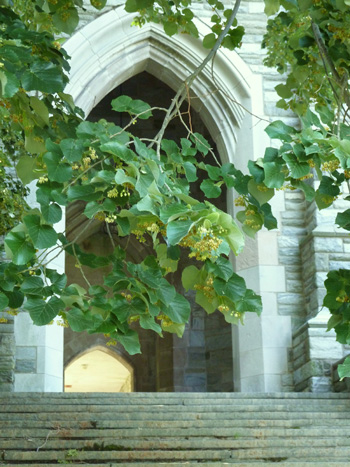 I first met the tilias as a horticulture student at Virginia Tech. Their scent permeated all of small downtown Blacksburg, Virginia. Pedestrians slowly passed, noses in the air, trying to identify the sweet mysterious perfume. Most gave up, not realizing that the smell belonged to a small unassuming tree. It has been some years since my time as a student and with the passing of time I lost touch with the tilias. A historic American linden in full flower (and thus quite fragrant), Tilia americana, planted by the Swarthmore College class of 1874 reacquainted me with the genus.
I first met the tilias as a horticulture student at Virginia Tech. Their scent permeated all of small downtown Blacksburg, Virginia. Pedestrians slowly passed, noses in the air, trying to identify the sweet mysterious perfume. Most gave up, not realizing that the smell belonged to a small unassuming tree. It has been some years since my time as a student and with the passing of time I lost touch with the tilias. A historic American linden in full flower (and thus quite fragrant), Tilia americana, planted by the Swarthmore College class of 1874 reacquainted me with the genus.
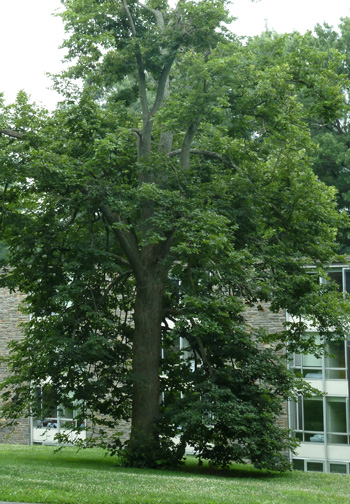
Tilia americana photo credit: J. Coceano
Tilia americana, also known as basswood, is native to the eastern half of North America. The stately tree can be found from Canada to Florida and west to North Dakota, Oklahoma, and Louisiana. Basswood thrives in full sun to part shade and prefers deep, moist soils along stream beds and valleys. The deciduous tree can be found on drier, rocky slopes but fails to reach maximum size. Heights of 60 to 80 feet are common but can exceed 100 feet. Young basswood trees develop a pyramidal shape that eventually develops into a rounded crown with maturity.
Tilia americana are ecologically significant trees. Basswood is an excellent source of pollen and nectar. Small mammals relish tilia seeds. In Bringing Nature Home, Douglas Tallamy states that its most signigficant contribution comes from the food source the leaves provide to over 150 species of North American caterpillars. The heart-shaped leaves have serrated margins and are coarse in texture. Flowering occurs in June. The small, fragrant flowers are held on pendulous cymes with an attached leafy bract called cladodes.
Basswoods were among the first trees cultivated in North America. The tree had multiple uses and was grown for its light, carvable wood and fibrous bast as well as a honey plant. Basswood honey is pale yellow, yet possesses a strong lingering flavor recommended for use in salad dressings and marinades. Native Trees for North American Landscapes by Guy Sternberg with Jim Wilson delves into the deep history of the American linden. Records indicate that seed collected by Mark Catesby in 1726 made its way to London, England where it was successfully grown. Archaeological records note that basswood bark was identified in ceremonial jewelry in Native American graves over 2,000 years old throughout Canada.
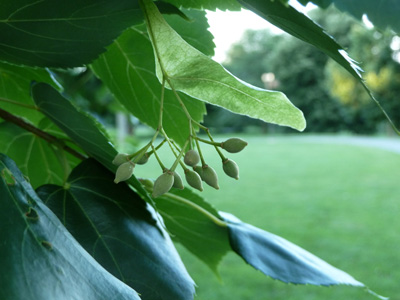
Tilia 'Harvest Gold' cladodes. photo credit: J. Coceano
Ideally, basswood should be grown in very open locations. The tree is tenacious in its desire to grow and often produces basal sprouts. The sprouts aid the tree in its ability to quickly regenerate after lightning or fire destroys the central leader. Individual trees possess an affinity for growing either a main leader or being a persistent clumper. Guy Sternberg promotes allowing a clumping linden to grow unfettered as such specimens are very graceful. Remove surplus basal sprouts as they develop. Another consideration comes with the litter produced after flowering. While unnoticeable in the landscape, the litter collects on paths or walks. Cultivars like ‘Redmond’ and ‘Boulevard’, selected for particular crown growth or strong central leaders, are available.
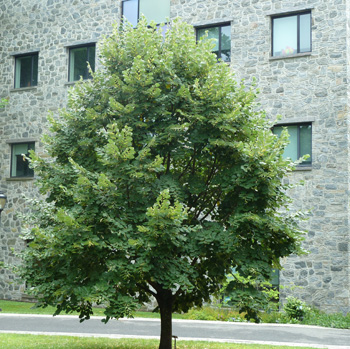
Tilia tomentosa 'Sterling' photo credit: J. Coceano
Taxonomy of this genus is often described as a “hopeless mess.” Like oaks, lindens have a strong affinity to cross pollinate with other species creating a variety of hybrids. Tilia heterophylla, white basswood, is recognized as the only other native species of consequence, although some would debate whether it is a tomentose variant of T. americana. Other species of Tilia are found throughout the Northern hemisphere including Tilia cordata, the littleleaf linden.
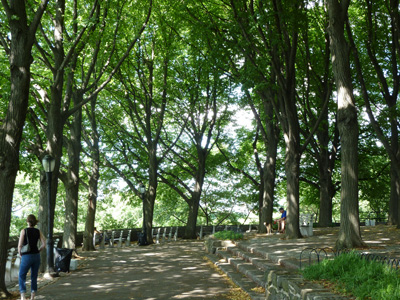
Tilia allee at Fort Tryon Park, NYC. photo credit: J. Coceano
In Asia and Europe, lindens are known as limes, though they are not related to the genus Citrus. Limes are commonly pleached, a pruning technique that results in plants trained as raised hedges, then shaped to form a flat plane. The formal, restrained allées and hedges are common in grand European gardens. The result can be lovely, though requires extra maintenance.
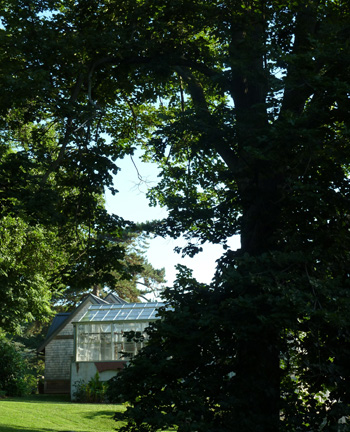
Tilia americana class tree of 1874 with a view of the Wister Center. photo credit: J. Coceano
The Scott Arboretum houses a diverse collection of Tilias, including two historically significant trees planted by the class of 1874 and 1886. A suggested route to view these trees would be to begin at Willets Hall and walk across campus, bisecting Magill Walk to Clothier Hall.





Kim Brainard
Posted at 14:13h, 11 SeptemberI live in Minnesota in a primarily basswood wood, some oak, maple, boxelder, ash and elm, a random cottonwood or walnut and there used to be black cherry trees.
Recently i noticed landscapers are planting little leaf linden. And the average Joe around here assumes they are basswood. They are not. I then noticed even rhough we have a great many basswood the DNR is not collecting seeds in our county.
I am guessing we have too many little leaf linden and they are afraid of getting genetically impure seeds.
Can cross pollination eventually change the nature of my beloved basswood?
Mary Tipping
Posted at 14:53h, 16 OctoberAssuming that your beloved basswood is Tilia americana, the species that cross-pollinate readily are Tilia cordata and Tilia platyphyllos.
Regards,
Mary Tipping,
Curator and Plant Recorder
Kim Brainard
Posted at 14:23h, 11 SeptemberI do not understand why they are planting little leaf linden when basswood are so easy to propagate. There seems to be now height difference. Is it just a marketing thing combined with people being ignorant to the fact that they are planting a non native species that could detrimentally affect our basswood?
Kim Brainard
Posted at 14:25h, 11 SeptemberI hope someone is still there to answer my questions as i see this was posted in 2011
Becky Robert
Posted at 14:34h, 11 SeptemberDear Kim, We are still active on this blog. I have just sent your question to our horticulturist and curator. Hopefully I will have an answer soon.
Sincerely,
Becky Robert
Scott Arboretum